New England-based cartoonist K.L. Ricks recently gained a bigger audience with her eerie, atmospheric comic for Hazlitt, “Country Darkness.” The strip concludes with its third part this Wednesday. Part 1 introduced two college roommates, one of whom goes out for an ill-advised late night run; part 2 sees her confronted with an ambiguous, shadowy creature out in the woods. With an Adventure Time variant cover out, editorial illustration work, several comics projects unfolding, and an unstoppable swarm of weird, beautiful fanart, K.L. Ricks is pushing on all pistons. I spoke to K.L. over Skype about process, horror, and the power of black-and-white photography.—A.M.
Interview conducted, transcribed, and edited by Annie Mok.
Mild spoilers for “Country Darkness” follow.
ANNIE MOK: The first thing that struck me as I was going over your blog is how much of what looks like what I think of as “signature work,” stuff that’s in your portfolio and looks just incredibly strong and well-worked out—is really recent...
K.L. RICKS: Yeah! [laughs]
MOK: How has making work been recently? Have a lot of creative threads and working methods been coming together for you recently? Because that’s what it looks like from your work.
RICKS: Yeah, I think just a lot of different opportunities have come up, and having projects to work on boosts my creative energy. And already working on stuff, I already have the momentum. A lot of stuff has been happening all at once! [...] I actually wrote the script for [“Country Darkness”] over a year ago, and just haven’t had the opportunity to work on it. But luckily I pitched to Anshuman [Iddamsetty, comics editor of Hazlitt] and he was happy to have me. It’s been really nice to get it out there, and it’s been great working with him.
 MOK: I saw your thumbnails, which are interesting because they’re so clear. They’re still gestural, but they’re very schematic. I was wondering if that is maybe an offshoot of working on editorial illustrations? Because of course you do a lot of editorial work for The New York Times and other places. I was wondering if Anshuman’s editing [the specifics of that story] and if you did [the thumbnails so clearly] partially for that reason?
MOK: I saw your thumbnails, which are interesting because they’re so clear. They’re still gestural, but they’re very schematic. I was wondering if that is maybe an offshoot of working on editorial illustrations? Because of course you do a lot of editorial work for The New York Times and other places. I was wondering if Anshuman’s editing [the specifics of that story] and if you did [the thumbnails so clearly] partially for that reason?
RICKS: Anshuman actually hasn’t edited the story at all.
MOK: That was actually my experience with [writing] Swim Thru Fire, so I was curious.
RICKS: If there is editing, it’s from me. The clarity is, that’s just how I do. That’s just how I do thumbnails, I want to make it absolutely clear to whoever’s seeing it, in case I can’t be there to explain it.
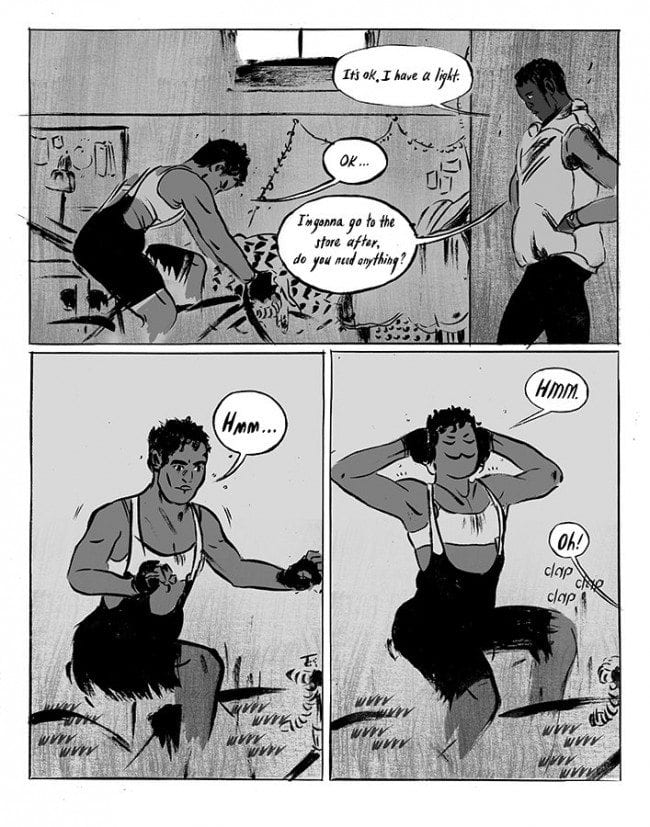 MOK: This story is trucking in horror and magical realism (which, I’ve had conversations about that term where people think that’s a misnomer or overly vague)... A lot of your stories work in this mixing of a prosaic, grounded situation, and introducing magical elements into that. And the use of heavy shadows. I know you’re a huge movie fan, and screening a lot of movies [at home] because you post them on Instagram—so I’m curious about your interest in horror, and your process around shadows and light. And isolation and monstrousness—the way the story isolates characters in this dark space. Can you talk about developing that tone, and where influences might have come from in developing the story?
MOK: This story is trucking in horror and magical realism (which, I’ve had conversations about that term where people think that’s a misnomer or overly vague)... A lot of your stories work in this mixing of a prosaic, grounded situation, and introducing magical elements into that. And the use of heavy shadows. I know you’re a huge movie fan, and screening a lot of movies [at home] because you post them on Instagram—so I’m curious about your interest in horror, and your process around shadows and light. And isolation and monstrousness—the way the story isolates characters in this dark space. Can you talk about developing that tone, and where influences might have come from in developing the story?
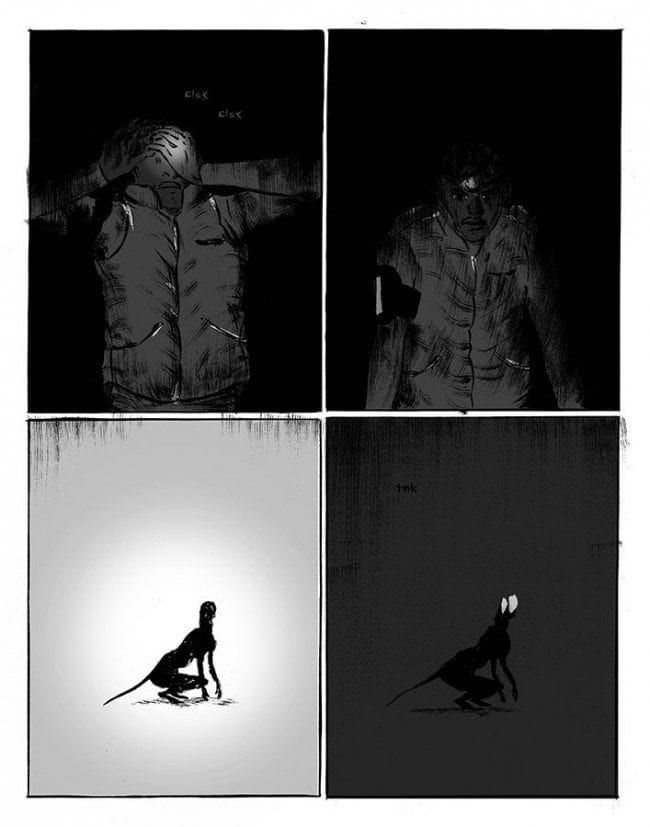 RICKS: The tone, that’s just a type of horror I’ve always been interested in. I like all different kinds, but I like Rosemary’s Baby, or Jacob’s Ladder... Altered States, that leans more sci-fi, but I guess is also a horror movie—this guy is having a horrifying, atypical experience [laughs], and he’s the only one who can get himself through it, and he’s kind of unwilling to reach out for help. And also, in the comics format, how do I translate that to a non-moving format? [...] As much as I love film, and as much as it influences my work, I also want to push the comics medium itself, and do the things that only comics can do, that a film or prose can’t. The origin, I was out running one night in the country where I live, and it was too dark to be out, and I was like, “Gotta get home! [laughs] Gotta get to my car!” If you’re running in the country at night, you’ll see animals a lot of the time. I’ve been out and seen a block ahead of me, or a few feet ahead of me, an animal skittering around. Like, I know what kind of animal it is, but what if it wasn’t what I thought it was? [they both laugh] What if it wasn’t just a raccoon, what if it wasn’t just a possum? That’s kinda like how I got the cogs going. And you asked about light—that’s me wanting to push… I’ve said before on Twitter, because I work primarily in what is strictly a black and white medium, being ink on Bristol paper, I like trying to push it. For me, it’s very easy to create harsh, sharply-defined imagery. But I always want to see how I can make something that’s literally in the gray area, or something that’s delicate, or soft with black ink on white paper.
RICKS: The tone, that’s just a type of horror I’ve always been interested in. I like all different kinds, but I like Rosemary’s Baby, or Jacob’s Ladder... Altered States, that leans more sci-fi, but I guess is also a horror movie—this guy is having a horrifying, atypical experience [laughs], and he’s the only one who can get himself through it, and he’s kind of unwilling to reach out for help. And also, in the comics format, how do I translate that to a non-moving format? [...] As much as I love film, and as much as it influences my work, I also want to push the comics medium itself, and do the things that only comics can do, that a film or prose can’t. The origin, I was out running one night in the country where I live, and it was too dark to be out, and I was like, “Gotta get home! [laughs] Gotta get to my car!” If you’re running in the country at night, you’ll see animals a lot of the time. I’ve been out and seen a block ahead of me, or a few feet ahead of me, an animal skittering around. Like, I know what kind of animal it is, but what if it wasn’t what I thought it was? [they both laugh] What if it wasn’t just a raccoon, what if it wasn’t just a possum? That’s kinda like how I got the cogs going. And you asked about light—that’s me wanting to push… I’ve said before on Twitter, because I work primarily in what is strictly a black and white medium, being ink on Bristol paper, I like trying to push it. For me, it’s very easy to create harsh, sharply-defined imagery. But I always want to see how I can make something that’s literally in the gray area, or something that’s delicate, or soft with black ink on white paper.
MOK: That delicacy makes a lot of sense to me, especially with brush work, there’s something tender about it. The use of grays is interesting to me—taking a physical a physical piece of artwork that is mostly black and white, but with some grays, in your case you’re using a lot of drybrush—and then [digitally] adding in medium gray tones, and cutting away with light into those. Subtlety of light is something that’s been widely ignored in Western comics, and when I started to see certain creators pushing that, like Emily Carroll, and you, and Jillian Tamaki—it comes as a real revelation, I feel like. Light is such an essential quality for all photography and all film… Did it come, maybe, partially as a reaction against the way other comics looked?
RICKS: Maybe not a reaction, I think it’s just something I’ve always been interested in, in film, in black and white film, and also in black and white photography. I don’t have a dislike for color, I love color, but I love... A good black and white photo really gets me.
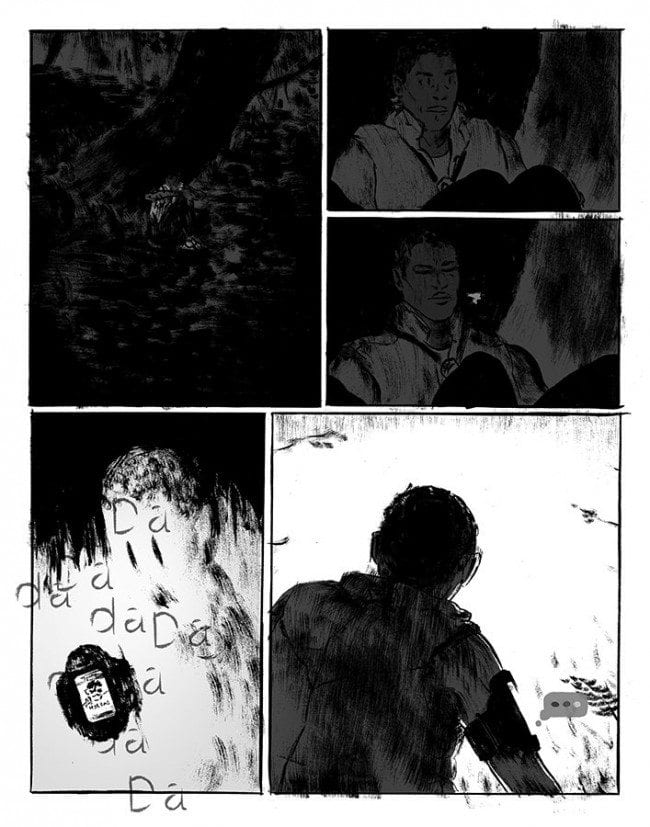 MOK: I saw you talking about Gordon Parks on your [Instagram].
MOK: I saw you talking about Gordon Parks on your [Instagram].
RICKS: Yeah, his work, and also Berenice Abbott, Robert Mapplethorpe, Ansel Adams. It’s harder, maybe not for everyone, but it’s very hard to make a black and white image pop and sing the way a color photo would. When someone does that well, I’m all about it, and that’s kind of what I want to get.
MOK: Is there something important to you about the restriction of black and white?
RICKS: Yeah!
MOK: It seems powerful in your work.
RICKS: I love seeing people creating a lot out of nothing, so to speak, yeah.
MOK: Speaking of what you were saying about things only comics can do, in the [upcoming] third part of “Country Darkness,” without giving away anything, there’s a sequence between these two roommates, Michelle and Helena, where the speech balloons are empty. This comes after this horrific, amorphous incident in the woods with this dog creature. That kind of suggesting dialog, or suggesting something and taking it away, but leaving this ghost trace of where the dialog would be, is a really strong use of [the] comics form. Can you talk about that kind of reduction?
RICKS: That initially came out of drawing the scene over and trying to think of what to put in the dialog, what would work. And I was like, what would work? Nothing! It doesn’t need dialog. But what if we just leave the speech bubbles, there’s no hurt in trying. I’m always down to try new things. If it doesn’t work, I’ll learn from it, and if it does work, that’ll open the gate to be more experimental.
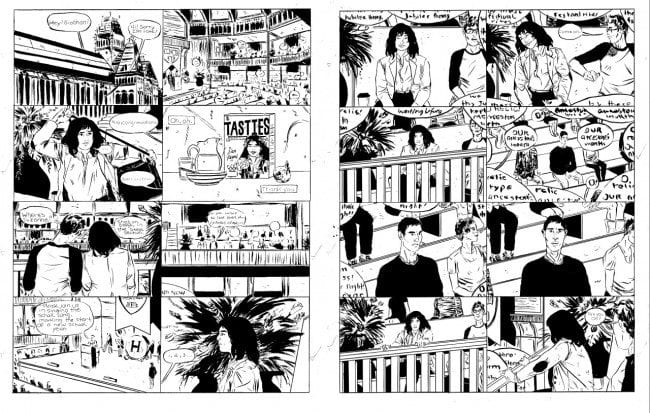 MOK: Speaking of experiments, you speak of this comic “Prof. Lewis” for Frank Santoro’s 2013 Comics Workbook Competition as being this watershed comic for you. It plays with legibility, the way that again, you’re redacting information. You tease word balloons that are cut off at the beginning, where they say “Jubilee” and “Storm,” so you’re getting this thing about X-Men. What I get from the story, and you can correct me if my reading is wrong, is that it was about superpowers, and about a denied sense of superpowers. I was interested in this sense of pulling away and really just suggesting this thing about… I’m seeing these threads in your stories, in “Familiar,” about these ideas of developing power, and maybe not being ready for it. In “Familiar,” the ways these animals are approaching this kid and the parents say, “Oh, she can’t talk yet” when the animals are trying to talk to her. And then the teacher in “Prof. Lewis” is resisting or denying or fearing her superpower. Can you talk about that thread in these stories?
MOK: Speaking of experiments, you speak of this comic “Prof. Lewis” for Frank Santoro’s 2013 Comics Workbook Competition as being this watershed comic for you. It plays with legibility, the way that again, you’re redacting information. You tease word balloons that are cut off at the beginning, where they say “Jubilee” and “Storm,” so you’re getting this thing about X-Men. What I get from the story, and you can correct me if my reading is wrong, is that it was about superpowers, and about a denied sense of superpowers. I was interested in this sense of pulling away and really just suggesting this thing about… I’m seeing these threads in your stories, in “Familiar,” about these ideas of developing power, and maybe not being ready for it. In “Familiar,” the ways these animals are approaching this kid and the parents say, “Oh, she can’t talk yet” when the animals are trying to talk to her. And then the teacher in “Prof. Lewis” is resisting or denying or fearing her superpower. Can you talk about that thread in these stories?
RICKS: I think that’s just a story, a thread that I’ve always been interested in, personally, as a storytelling dynamic. Someone who’s not ready, but has to stack up, and how they react under that pressure.
MOK: Is “Familiar” continuing, or is that a one-time story?
RICKS: That’ll keep going, I have a longer story in mind. I like doing short stories as a sort of character development, exploring the space. I’ll have some more short comics coming out before I start working on a longer one. All my energy is focused on “Country Darkness” and that strain of comics.
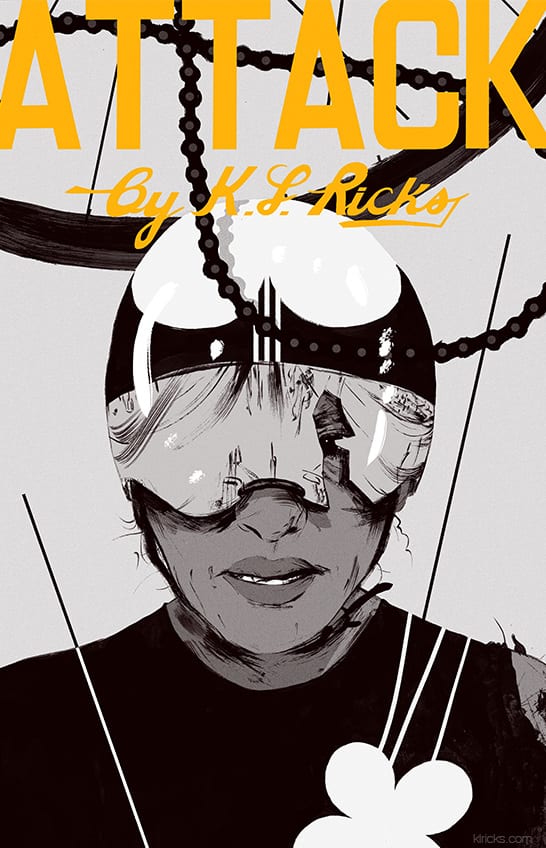 MOK: On your Patreon and on your blog, you’re talking about developing—and I do a similar thing, I guess—but developing a lot of stories at once. You talk about this comic “Attack” on an all-women’s bicycle team in Boston, the witch comic/s “Familar” and “Naima,” and also “Country Darkness.” What’s it like developing so many projects at once, and how does that work for you?
MOK: On your Patreon and on your blog, you’re talking about developing—and I do a similar thing, I guess—but developing a lot of stories at once. You talk about this comic “Attack” on an all-women’s bicycle team in Boston, the witch comic/s “Familar” and “Naima,” and also “Country Darkness.” What’s it like developing so many projects at once, and how does that work for you?
RICKS: I like doing it that way. I always end up, no matter how excited I am, getting burnt—not even burnt out, just “I don’t wanna think about this anymore, I wanna think about this other project instead.” And then I’ll go back and flip-flop, and go all around the table.
 MOK: In this illustration [“Naima”], I’m curious if there’s an influence for you from fashion and fashion photography… I love the ways that clothes are hanging on [your] characters, and in the case of that illustration, the way the clothes are lightly floating up. Saying Mapplethorpe makes a lot of sense to me because of his theatricality. I’m wondering where that’s coming from for you?
MOK: In this illustration [“Naima”], I’m curious if there’s an influence for you from fashion and fashion photography… I love the ways that clothes are hanging on [your] characters, and in the case of that illustration, the way the clothes are lightly floating up. Saying Mapplethorpe makes a lot of sense to me because of his theatricality. I’m wondering where that’s coming from for you?
RICKS: I love fashion! It’s something I wish I had studied more in school. Because it’s something I don’t do, I’m fascinated by it in a different way than something I’m very well-versed in.
MOK: What was your major at RISD?
RICKS: I studied illustration.
MOK: What was your experience there like?
RICKS: I had a good time. It was a brand-new experience, but overall I had a good time. I definitely have criticisms, but...
MOK: You can go into that, or not.
RICKS: Oh, yeah! I love RISD and I’m thankful for, above all, all the people I met. But... I can’t speak for other art schools, but they very much romanticize the unhealthy work style. Cheekily throughout, in every aspect—the school paper’s called The All-Nighter, stuff like that. Just very hard—kids there, they work so hard, they’re so needlessly hard on themselves and the school does nothing to assuage that.
MOK: I can say from my experience at MCAD, the Minneapolis College of Art and Design, it was the same, and I think that’s really common at art schools. I’ve had a lot of conversations with other people about it, and I’m happy to hear you say it, because it is something that I see across the board with art students, and often with younger or starting-out cartoonists and illustrators. I find it incredibly toxic, and unnecessary.
RICKS: Just please, please everyone, sleep and drink a lot of water!
MOK: I’m so with you on the water! So you said you’re really thankful for the people that you met there, which leads me into something I was curious about, which is, who is your crew? Who are your peers, people you identify with or talk to about work, people you met in college and afterwards.
RICKS: Who did I meet? I met Odera Igbokwe, Leland Goodman, Irene Koh. I met a lot of people outside of RISD, online or at MoCCA or whatever, like Kris Mukai. Sophia [Foster-Dimino], we overlapped but we didn’t get to really know each other til after we both graduated. My comics teacher R. Kikuo Johnson has definitely been a huge influence.

MOK: Oh my gosh, he’s so incredible, it’s so cool to hear that you had him. What was being in his class like?
RICKS: It was great! I can’t sing his praises enough. He’s an excellent teacher and I’m glad to be able to count him as a friend.
MOK: I’m always curious because I had a few different kinds of comics teachers over time—in high school I went to an SVA summer program with Keith Mayerson, Yuko Shimizu, and Gary Panter, and in college I had Terry Beatty and Barb Schulz who were mainstream-leaning, and Zak Sally who of course is not, and then I took Frank Santoro’s Correspondence Course. So I’m curious about what Kikuo Johnson’s teaching style was like, and what he was having you do?
RICKS: If I remember correctly, it feels like it was a thousand years ago, but it was only my freshman year—he was all about clarity and storytelling, as opposed to individual style. He was all, however you want to draw, however you get the point across, but just making sure that the viewer isn’t needlessly lost or confused by the structure of the story in a way that’s not to your advantage. He taught us all about history of comics, and he included manga in that as well. I think if I had had a teacher who was more focused on style, I don’t think I would have blossomed in the same way.
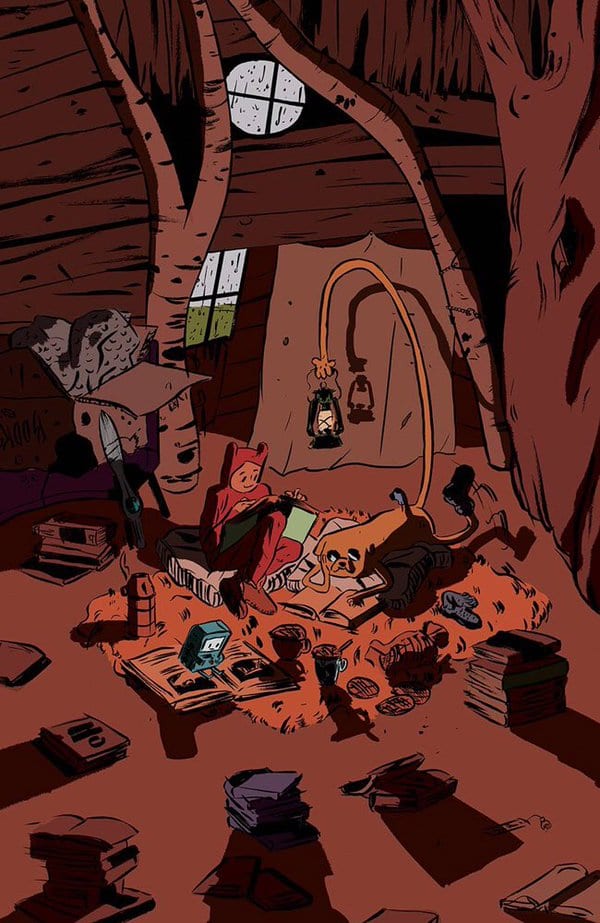 MOK: Speaking of style, it was so cool to see your Adventure Time cover, because it was so in your mode of loose brush linework and heavy shadows. I feel like you really pushed those characters and that design more than I had seen people do, while keeping them recognizable. That’s something I see in a lot of your fan art, bringing your own hand into things you’re drawing from other sources. Can you talk about that, and synthesizing a lot of images?
MOK: Speaking of style, it was so cool to see your Adventure Time cover, because it was so in your mode of loose brush linework and heavy shadows. I feel like you really pushed those characters and that design more than I had seen people do, while keeping them recognizable. That’s something I see in a lot of your fan art, bringing your own hand into things you’re drawing from other sources. Can you talk about that, and synthesizing a lot of images?
RICKS: I’m really glad that that came across! That was my goal. I was like, this is not at all how I normally draw, but I want to draw how I normally draw, without adapting… I want to adapt the characters without losing them. That’s the kind of fan art I like—I want to see the artist’s take more than anything. I’ll look at things—I don’t know what it is [laughs] and if I can see the artist’s heart and love in their take on it, I’m all in.
MOK: I agree, I love fan art, but I love this idea of the artist’s heart coming across. Speaking of which, you did this Tumblr “8 Questions” thing—you said something very salient, and it’s something in which I see people responding to you, responding to your work—you said: “I tell myself to relax and be bold with my mark making and concepts. Fear and indecisiveness reads in work, but so will confidence.” It reminded me of this thing I was seeing in Jane Smiley’s Thirteen Ways of Looking at the Novel. Readers were coming up to her and saying that they loved her novel A Thousand Acres, and she wanted to be like, “Yeah, right.” She said, “I found that novel interesting, moving, and challenging, but I don’t find it loveable or even very relate-to-able [...] What many readers are responding to, I think, are focus and intensity. The novel has an unrelenting quality to it that is inherently involving and comes from the form of tragedy itself.” Something that I see people responding to in your work… I liked this tweet that Anshuman had when part 2 went up, of “Country Darkness”—he said, “country darkness it just went 0-100” [they both laugh]. Which I loved, using that Drake-y term. Can you talk about that going to 100, with your work? I think that’s such a huge part of what people are responding to, and what I respond to.
RICKS: Going to 100… I just try to dole it out in a way that… That’s how I do a lot of things. I talked about this before—I respond to Paul Thomas Anderson’s work in a way that I don’t respond to a lot of straight white male filmmakers, ‘cause he knows how to pull his.... He knows how to pull the bow taut, and let it go, and absolutely destroy you [laughs].
MOK: I saw Punch-Drunk Love when I was high once in college [K.L. laughs]. It was a terrible decision! I have had few experiences more uncomfortable than watching that movie [laughs], for that exact reason!
RICKS: That’s an aspect of storytelling that I strive for. To know when to strike.
MOK: Speaking of movies, I was so happy to see your Star Wars list [on Instagram].
RICKS: [laughs] Some people were not!

MOK: [laughs] No, I was so happy. This comes back to this thing about plotting, and knowing when to pull the arrow back, reining this tightness for the viewer and releasing it. You put Force Awakens, New Hope, and Empire on top—and I think those three do the best job of pulling that arrow. These comparisons [between the movies], I think, are very interesting to make.
RICKS: So the prequels [...] these viewings are the first time I’ve ever seen them before. The only part [of the prequels] I’d ever seen is five minutes of the pod race in the first one, and the part where Obi-Wan is taking Anakin’s blood to test it for midichlorians. And that’s it [laughs].
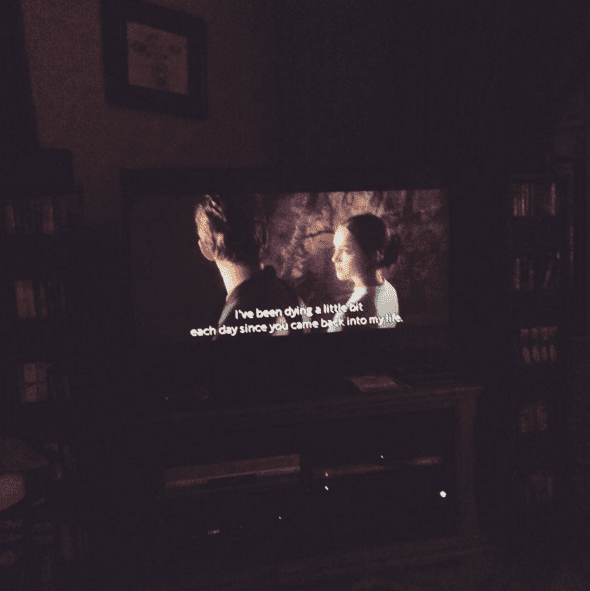
MOK: Talk about drama! “Oh… Got a lot of midichlorians. Whoa. Yeah, bro.”
RICKS: [laughs] I re-watched the original trilogy relatively recently, over the summer before I moved [to Boston]. We had A New Hope on VHS, and I’d seen it a lot—comparatively not a lot compared to some other people. We were never really a Star Wars family, we were more of an Alien family [...]
[At this point K.L. and I talked for a long time about Star Wars; K.L. thinks the prequels overall are pretty good except for the rampant racism and Amidala’s character having gotten a raw deal.—A.M.]
 MOK: So, speaking of sci-fi [they both laugh], you have a couple pieces on your blog of this character Anyanwu from Wild Seed by Octavia Butler; and one of a couple pieces for Gowanus Print Lab shows that K.J. Martinet runs, and this is this piece “Evening, Morning, Night” inspired by this novelette The Evening and the Morning and the Night by Octavia Butler. I love these two drawings, and something I’m interested in in both of them is they have this thread of body horror. I shamefully haven’t read any Octavia Butler, all my friends love her [laughs]...
MOK: So, speaking of sci-fi [they both laugh], you have a couple pieces on your blog of this character Anyanwu from Wild Seed by Octavia Butler; and one of a couple pieces for Gowanus Print Lab shows that K.J. Martinet runs, and this is this piece “Evening, Morning, Night” inspired by this novelette The Evening and the Morning and the Night by Octavia Butler. I love these two drawings, and something I’m interested in in both of them is they have this thread of body horror. I shamefully haven’t read any Octavia Butler, all my friends love her [laughs]...

RICKS: I’ve only started reading her recently!
MOK: But I read about The Evening and the Morning and the Night being about psychosis and self-harm, and this piece of yours is about this woman with these parts of her mutating and floating away. It’s her arm, this site of power. Then similarly, in this sketch of the character from Wildseed, there’s kind of spikes or growths coming out of their right shoulder and arm, and it seems to be poking through another character’s hand. Can you talk about visualizing and playing with ideas around changes in bodies, and maybe feelings of bodies doing things that we don’t have much control over?
RICKS: Unless I’m mistaken, I definitely looked at that sketch I drew as a starting off point for the finished Gowanus piece. In both of them, I wanted to encapsulate, and hint at the power or the curse that these characters deal with. And just going for a sort of editorial clarity in a sci-fi illustration.
MOK: I really hope you get to do covers for [SF/F publisher] Tor Books or something.
RICKS: I would love that!
MOK: Both these pieces are excellent examples of something I see throughout your work, which is this very gestural, observed quality to figures with strong acting, and projection of an inner process behind the character’s eyes and in their posture. I see influences from R. Kikuo Jonhson and Jillian Tamaki in there, who I know you listed as influences, along with Mignola, Lynda Barry, Tomine, Ware, Clowes, Shaw, The Dark Knight Returns, in this list that you made last April. Which is also interesting because then there are times, certain panels, and then your self-portrait, where you put in this super cartoony manga cat-mouth smile. I’m curious about your approach to figures, acting, gesture, and also playing against that super-observed, illusionistic style with other drawing vocabularies.

RICKS: I think it just comes down to me just—I want this to come across as clear as possible. I want the audience to know exactly what I mean. I want there to be almost no ambiguity, because it’s not written. There’s no, “she said sourly,” “she said slyly,” I want it to read. Also, always trying to push… I hope this is a good example: one of the things that I found appealing, and a lot of people find appealing about [Hellboy creator] Mike Mignola is how he gets image and weight across in his incredibly stylistic artwork. But that comes from decades of observing and drawing. He put in the work before he could strip it down and simplify it. That’s what I wanna go for: I observe, I draw. I’m always trying to learn new things and new ways. I’m always down to expand as an artist. I want to bring that into my work. And just keep evolving as an artist, and not stagnate. I’m always worried, like, “Oh, my character’s too stiff, and their mouth is not open enough!” So I’m always trying to push and expand.
MOK: Speaking of clearness and expression, I saw this series of illustrations you did about musicians, of Blondie, Peter Gabriel [K.L. laughs]... It looks like it was for We Draw Cute Boys?
RICKS: Yeah, that was a project my friend Leland and I did. It’ll always live on in our hearts, but the website’s on hiatus. It’s just like, “Let’s draw people we think are cute!”... That’s it!
MOK: This is a great starting point, I’m all for that, as you know—as people know from our Twitter conversations [they both laugh].
RICKS: I look back at old work and say, “That’s how I learned this, that’s how I decided this.” Everything is a learning opportunity.
MOK: Yeah, I really see this stuff from about a year ago, where you’re developing these ideas and these visual vocabularies that are coming together so strongly in your work now. It was also interesting to see these influences from music that you talk about, or just music favorite musicians—Blondie, Peter Gabriel, Elvis Costello, Sam Cooke, Nick Cave—and I’m a really big fan of Sam Cooke and Elvis Costello, and love Blondie as well. I liked what you wrote about Nick Cave: “He’s most famous for his extremely dark and violent work, but to me he’s a great example of someone who’s not afraid of being seen as vulnerable.” And that pointed out something to me about his work, which is the way he talks about fear and unsureness. I think of “The Mercy Seat.” I played “The Mercy Seat” on YouTube to remind myself of it since I was looking at this, and I looked through your blog, and I thought, “This is a perfect melding!” Like, if you designed a music video for Nick Cave, it would be perfect! [K.L. laughs] It’s always interesting to me to see—not necessarily influences—but music and comics being these mediums that maybe don’t have literal connections, since one is visual and one is not, but seeing these tones and ideas permeate.
RICKS: Huh. I love that! [laughs] I don’t know what to say. I’m so glad that you made that connection!
MOK: Can you talk about this idea of vulnerability that you like, and being seen as vulnerable, and maybe how it relates to your own?
RICKS: Even as a child, I’ve always loved work that was character-driven, and I’m fascinated by characters that have two faces—or have to put on a mask in order to function in a certain environment, but then they’re alone or with someone they trust, and it can melt away. Or when someone, either out of necessity or out of bravery, they let those two worlds overlap.
MOK: So you’re developing all these projects, but I’m so curious to ask what you’re excited for or interested in for the future. I saw you post this quilt you made, which was so cool, and seeing you experiment with what you call “color blocks”—is that an illustration term?
RICKS: Yeah, if you look at the artist Tiffany Ford’s work, that’s how she works. She’s a colorist for different Cartoon Network shows. Because color is not usually the medium I work in, it’s definitely the medium I struggle the most with. It’s not something that comes as quickly to me, I think just because I don’t focus on it as much as the other aspects of my work. That, for me, is just a way to really push myself. I’m always looking to push my work, and I don’t want to stall or stagnate or rest on my laurels, that sort of thing [...] I started to learn how to knit a few months ago, and I want to get back on that. I definitely want to do more quilts. I used to do watercolor, I want to get back into that and incorporate that into my comics in some way. Everything informs you, and I’m always game to learn and explore, anything.







